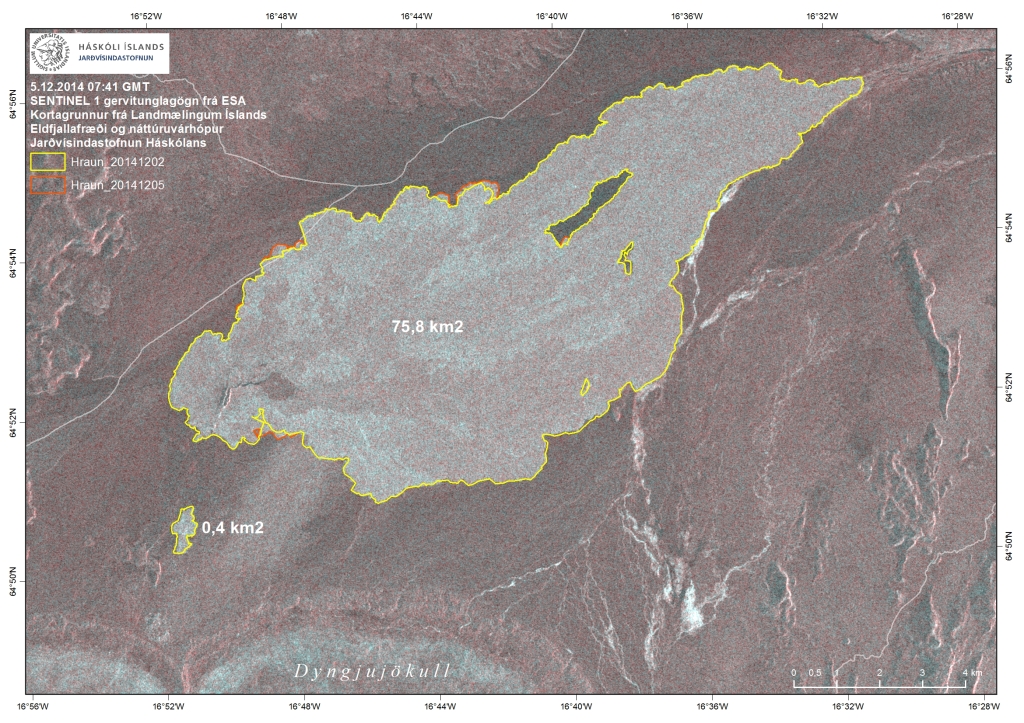The volcanic eruption in Holuhraun has lasted for 100 days
The Scientific Advisory Board of the Icelandic Civil Protection met yesterday, 8. December, as it does regularly three days a week. The scenarios, for the most likely development of the volcanic eruption in Holuhraun and the subsidence of Bardarbunga caldera, were reviewed at the meeting. As all devoted readers of our notes (published here) know, the Scientific Advisory Board recently concluded that the most likely development of the volcanic eruption, given the course of events until now, would be for it to continue for few months more. The eruption, which started on 31st of August, has now lasted for 100 days. A good overview of the eruption until now can be read here.
Below are the main points from the Scientific Advisory Board meeting yesterday and the updated scenarios. At the bottom of the page is an satellite image from ESA showing the lava field on December 5. The image is edited by the Institute of Earth Sciences, University of Iceland.
Main points:
- Insubstantial changes have been in the volcanic eruption in Holuhraun over the last few weeks. Tomorrow,Tuesday 9. December, will be 100 days from its outbreak.
- Seismic activity in Bardarbunga continues to be strong. The strongest earthquake since noon on Friday, 5. December, was magnitude M5,1 on Friday at 21:05. About 20 earthquakes between M4,0-5,0 were detected since Friday and 10 earthquakes between magnitude M3,0-4,0. In total about 300 earthquakes were detected in Bardarbunga since noon on Friday.
- Little seismic activity was detected in the dyke and around the eruption site in Holuhraun since Friday.
- GPS measurements show no changes. The subsidence towards Bardarbunga continues with similar rate as has been.
- Telecommunications with the GPS station in Bardarbunga caldera have not been established yet. Due to bad weather forecast it is unlikely that scientists will be able to travel to Bardarbunga in the next few days. A connection will be established with the GPS station as soon as possible.
Scenarios:
- The volcanic eruption has now been going on for over three months, the lava flow is still great in Holuhraun and the rate of the subsidence of the Bardarbunga caldera is still significant. Three scenarios are considered most likely:
- The eruption in Holuhraun continues until the subsidence of the Bardarbunga caldera stops. The
eruption can still go on for many months. - The volcanic fissure may lengthen southwards under Dyngjujokull, resulting in a jokulhlaup and an
ash-producing eruption. It is also possible that eruptive fissures could develop in another location
under the glacier. If such an eruption would be prolonged it could eventually produce a lava flow. - Volcanic eruption in the Bardarbunga caldera. Such an eruption would melt large quantities of ice,
leading to a major jokulhlaup, accompanied by ash fall. - Other scenarios cannot be excluded.
- The eruption in Holuhraun continues until the subsidence of the Bardarbunga caldera stops. The

SENTINEL 1 satellite image from ESA 5.12.2014. Image Institute of Earth Sciences University of Iceland.
